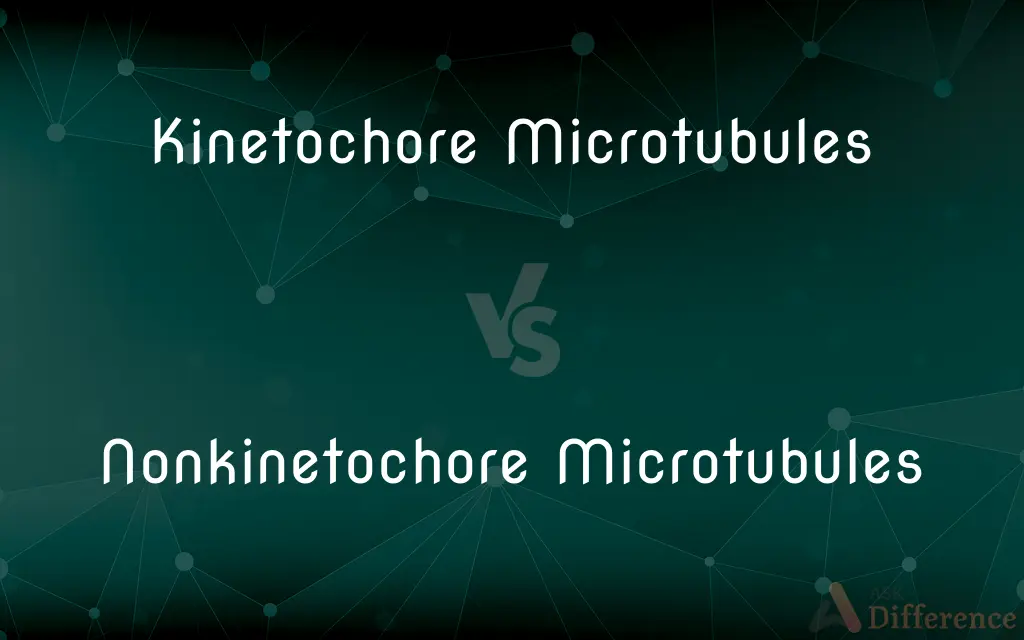Kinetochore Microtubules vs. Nonkinetochore Microtubules — What's the Difference?
By Tayyaba Rehman — Published on January 30, 2024
Kinetochore microtubules attach to chromosomes at kinetochores, aiding in chromosome segregation; nonkinetochore microtubules don't attach to chromosomes, but lengthen the cell during division.

Difference Between Kinetochore Microtubules and Nonkinetochore Microtubules
Table of Contents
ADVERTISEMENT
Key Differences
Kinetochore Microtubules are integral components of cell division, attaching directly to chromosomes at specialized structures called kinetochores. Nonkinetochore Microtubules, in contrast, do not engage with chromosomes but play a crucial role in cell elongation during division.
The primary function of Kinetochore Microtubules is to facilitate the movement of chromosomes towards the poles of a dividing cell. Conversely, Nonkinetochore Microtubules, although not interacting with chromosomes, are essential for the separation of cell poles, effectively increasing the cell's length.
During mitosis, Kinetochore Microtubules undergo dynamic assembly and disassembly, which is critical for the proper segregation of chromosomes. Nonkinetochore Microtubules, while also dynamic, primarily contribute to the mechanical forces necessary for the cell to elongate.
Stability and regulation of Kinetochore Microtubules are key to ensuring accurate chromosome segregation, preventing genetic abnormalities. Nonkinetochore Microtubules, though not directly involved in segregation, maintain the structural integrity of the dividing cell.
In summary, Kinetochore Microtubules are essential for chromosome alignment and segregation during cell division. Nonkinetochore Microtubules, while not directly involved in this process, are crucial for the spatial organization and mechanical aspects of cell division.
ADVERTISEMENT
Comparison Chart
Attachment
Attach to chromosomes at kinetochores
Do not attach to chromosomes
Role in Cell Division
Facilitate chromosome movement and segregation
Contribute to cell elongation and spatial organization
Interaction with Chromosomes
Direct interaction with chromosomes
No direct interaction with chromosomes
Mitotic Importance
Essential for accurate chromosome segregation
Important for mechanical separation of cell poles
Cellular Impact
Prevent genetic abnormalities through chromosome management
Maintain structural integrity during cell division
Compare with Definitions
Kinetochore Microtubules
These microtubules form spindle fibers that connect to chromosome kinetochores.
Kinetochore microtubules shorten during anaphase, pulling chromosomes towards cell poles.
Nonkinetochore Microtubules
Nonkinetochore Microtubules are spindle fibers not attached to chromosomes.
Nonkinetochore microtubules extend the dividing cell by pushing against each pole.
Kinetochore Microtubules
Kinetochore Microtubules are fibers that attach to chromosomes' kinetochores during cell division.
In mitosis, kinetochore microtubules pull chromosomes apart to opposite poles of the cell.
Nonkinetochore Microtubules
These fibers function independently of chromosomal movement during cell division.
Nonkinetochore microtubules operate concurrently with, but separate from, kinetochore microtubules.
Kinetochore Microtubules
Kinetochore Microtubules are dynamic structures critical for chromosome segregation in mitosis.
The stability of kinetochore microtubules is key to preventing errors in genetic transmission.
Nonkinetochore Microtubules
These microtubules contribute to cell elongation during mitosis.
The length of nonkinetochore microtubules determines the cell's size post-division.
Kinetochore Microtubules
Kinetochore Microtubules play a pivotal role in the accurate distribution of genetic material.
Any disruption in kinetochore microtubules can lead to chromosomal instability.
Nonkinetochore Microtubules
They are integral in maintaining the spatial arrangement of a dividing cell.
Nonkinetochore microtubules ensure the cell divides along the correct plane.
Kinetochore Microtubules
They are specialized microtubules essential for chromosomal alignment in cell division.
The precise control of kinetochore microtubules ensures equal chromosome separation.
Nonkinetochore Microtubules
Nonkinetochore Microtubules stabilize the cell's structure during division.
The absence of nonkinetochore microtubules can lead to irregular cell shapes.
Common Curiosities
Can cell division occur without Kinetochore Microtubules?
No, they are essential for proper chromosome segregation during division.
How do Kinetochore Microtubules contribute to genetic stability?
They ensure accurate chromosome segregation, preventing genetic abnormalities.
What is the role of Nonkinetochore Microtubules in cell division?
Nonkinetochore Microtubules assist in cell elongation and structural integrity during division.
Are Nonkinetochore Microtubules involved in chromosome movement?
No, they do not directly interact with chromosomes but aid in cell elongation.
What are Kinetochore Microtubules?
Kinetochore Microtubules are spindle fibers that attach to and move chromosomes during cell division.
What happens if Kinetochore Microtubules malfunction?
Malfunction can lead to improper chromosome segregation, causing genetic disorders.
Do Nonkinetochore Microtubules have a role outside of mitosis?
Their primary function is related to mitosis, specifically in cell elongation and structure maintenance.
Are Nonkinetochore Microtubules present in all cells?
Yes, they are present in cells undergoing mitosis.
How are Kinetochore Microtubules regulated?
They are regulated by cellular checkpoints and protein complexes for precision.
What is the primary difference between these two types of microtubules?
Kinetochore Microtubules interact with chromosomes; Nonkinetochore Microtubules do not.
Do Nonkinetochore Microtubules change length during cell division?
Yes, they elongate to assist in cell division and maintain structure.
Is the number of Kinetochore Microtubules consistent in all cells?
It can vary depending on the cell type and stage of division.
Can Nonkinetochore Microtubules affect cell shape post-division?
Yes, they play a key role in determining the final shape and size of the divided cells.
Are Kinetochore Microtubules visible under a microscope?
Yes, they can be observed using specific staining techniques during cell division.
How do changes in Kinetochore Microtubules affect cancer development?
Abnormalities in these microtubules can lead to chromosomal instability, a hallmark of many cancers.
Share Your Discovery

Previous Comparison
Linear Queue vs. Circular Queue
Next Comparison
Minecraft vs. Real LifeAuthor Spotlight
Written by
Tayyaba RehmanTayyaba Rehman is a distinguished writer, currently serving as a primary contributor to askdifference.com. As a researcher in semantics and etymology, Tayyaba's passion for the complexity of languages and their distinctions has found a perfect home on the platform. Tayyaba delves into the intricacies of language, distinguishing between commonly confused words and phrases, thereby providing clarity for readers worldwide.











































